In a noisy entrance to one of the oldest markets in Oaxaca City, not far from one of the sites where corn culture originated 9,000 years ago, muralist Mariel García stood on a scaffold in the hot sun for three weeks and painted her heart out. The mural she was creating, more than a year in the planning and execution, is a tribute to Mexico’s long struggle to protect the country’s more than 1,000 native maize varieties from contamination by genetically modified corn.
Para leer esta historia en español, vea Mural oaxaqueño documenta la lucha por defender el maíz nativo
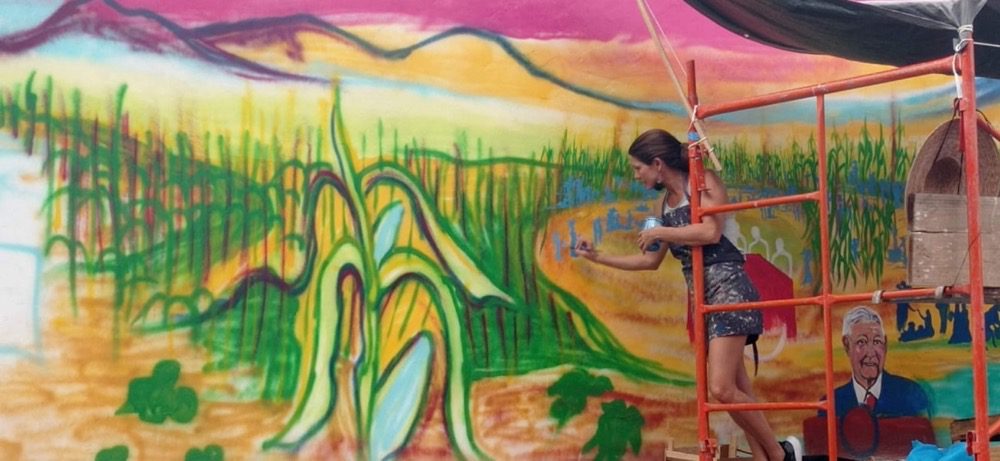
Garcia, born in northern New Mexico and now living in Mexico, is part of a bioregional and binational collective of artists, scientists and activists that has been working for more than a decade to raise awareness about the need to protect the diversity of corn and corn cultures of the Americas. And though García considers herself anything but political, the mural comes in the context of a lot of big money corn politics.
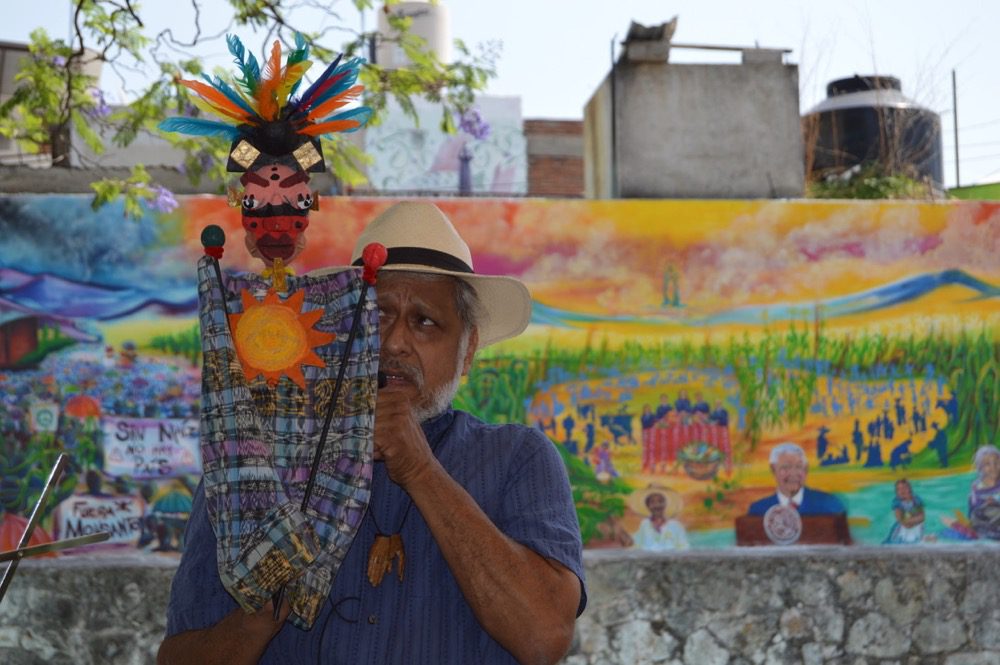
“When you turn daily news into a mural, you turn it into a legend to be looked up to by students of history in the future… and this one tells the story of how all of Mexico came together to save the corn and native milpa cultures,” explained Chris Wells, founder of the All Species Project, the motor behind the mural and García’s inspiration.
The milpa, the ancient and complex agricultural system that has supported life for millennia throughout Mesoamerica, is much more than corn, explained Wells. Recent studies have documented up to 191 different edible plants in a traditional milpa, including beans, squash, various varieties of chiles, tomatoes, edible greens, and medicinal plants. It is also a habitat for a wide variety of animals, including the native melipona bee, considered sacred to the Maya people who cultivate them. “The Milpa is Mexico’s gift to the Evolution of the Earth,” said Wells.
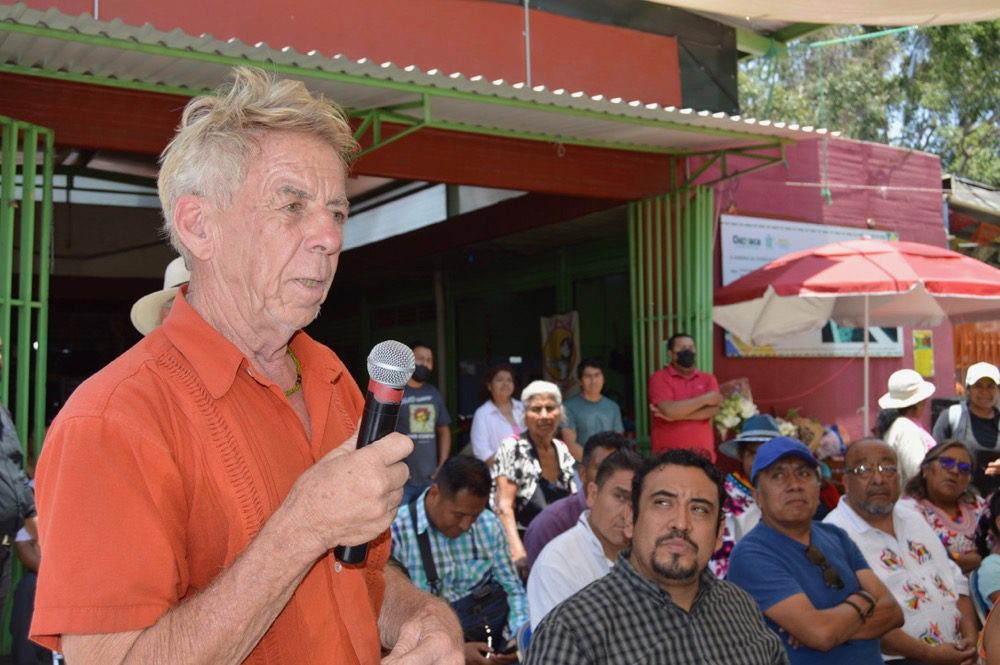
In the best tradition of Mexico’s Muralismo movement, Wells, a longtime native corn cultivator, songwriter and self-described “animateur” from New Mexico residing in Oaxaca, worked with Garcia for a year planning the sequenced stories of this 10-meter-by-3 meter mural and inauguration and raising the money to cover expenses. Garcia and other collective members donated their time. The mural was the latest in a series of symposiums, circuses, and a traditional Oaxacan calenda – a dancing procession of giant puppets – to raise awareness in Mexico and in the US about the threats to native corn and Mexico’s root cultures.
“These are people who were so innately agricultural that after 10,000 years they are still guarding more than a thousand corn varieties,” said Wells, highlighting indigenous and campesino corn culture across the American continent.
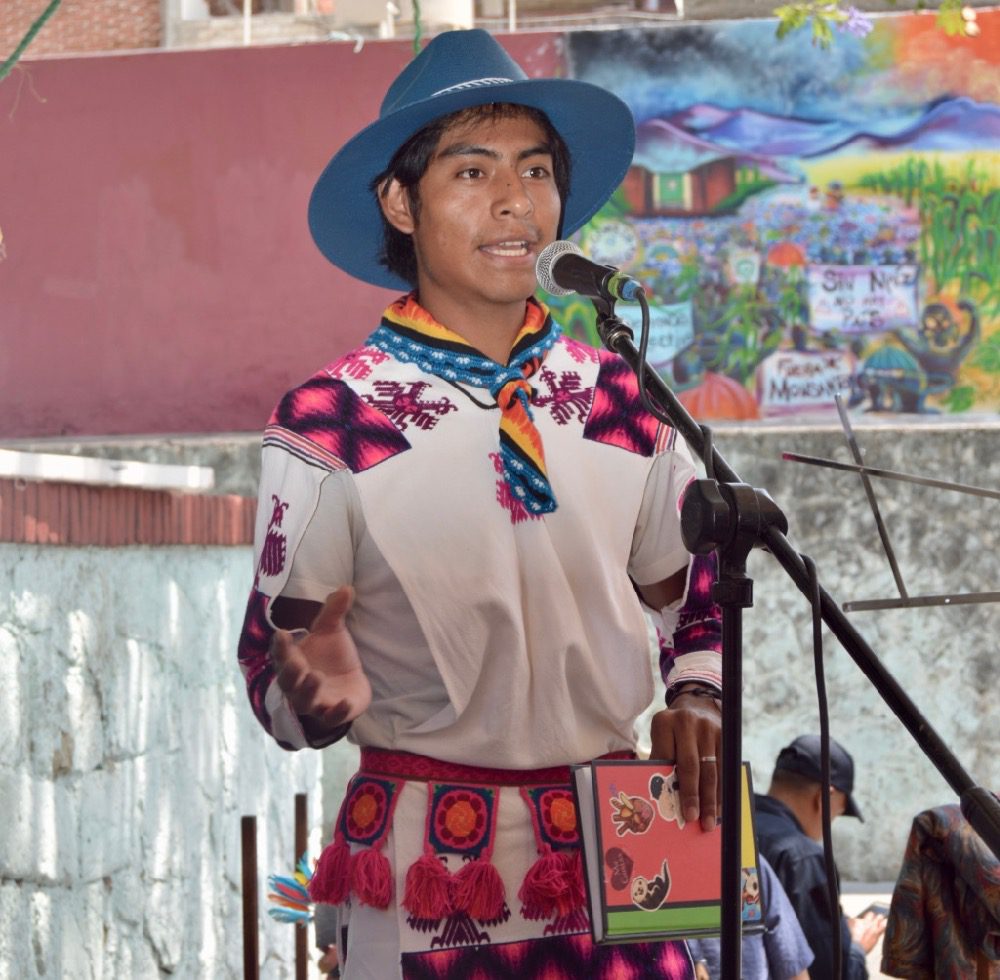
Corn has hit the headlines recently because of an ongoing trade dispute between the US and Mexico due to Mexico’s pending gradual ban on glyphosate and partial ban on transgenic corn, primarily for its use in the staple food, the tortilla. But the mural was originally conceived to celebrate a less prominent but much more powerful victory for native corn defenders: the approaching tenth anniversary of the Demanda Colectiva Maíz (class action) lawsuit against transgenic corn, which resulted in a decision by the Mexican Supreme Court to prohibit the production of GMO corn in Mexico.
Members of the All Species Project and the Demanda Colectiva gathered recently along with local market sellers, artists, performers, schoolchildren, city authorities and a host of other attendees to inaugurate García’s mural at the Mercado Sánchez Pascuas, and to pay homage to that long and diverse movement that is singular because it integrates art, culture and science.
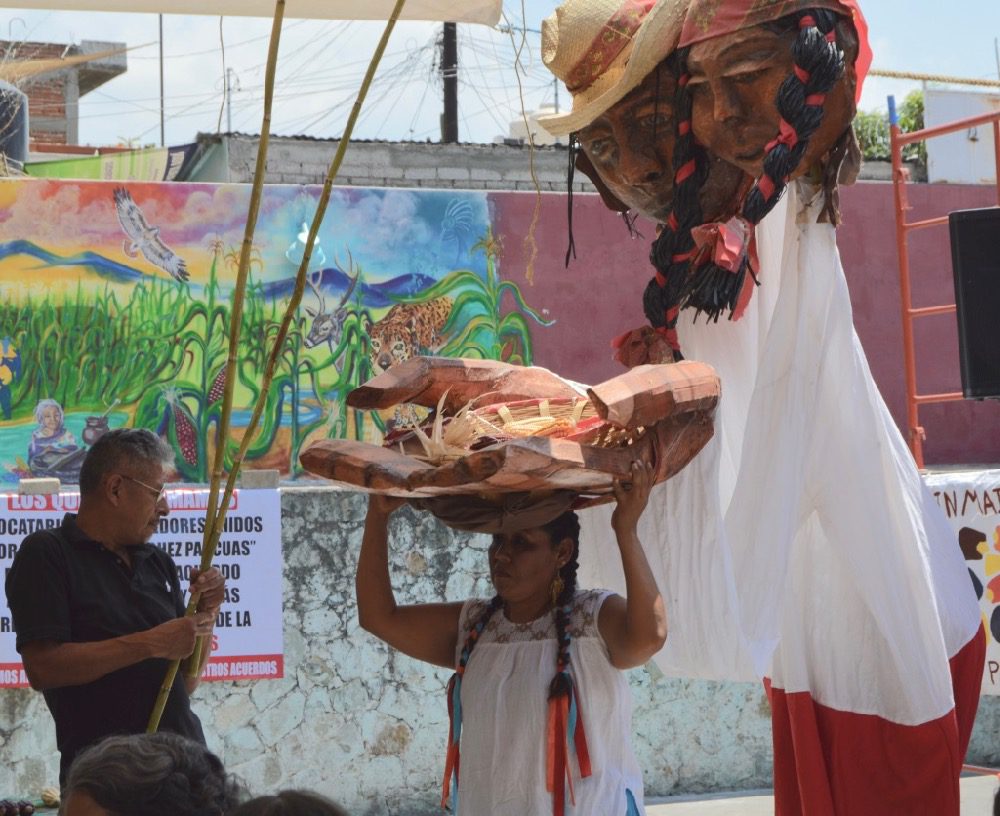
The mural as the backdrop of the entire event features a lush and verdant milpa in the highlands valley of Oaxaca where a rainbow of corn varieties has been cultivated for over 10,000 years. For millennia, indigenous cultures have celebrated corn’s four principal colors – red, yellow, blue and white– and an endless blend of mixtures and varieties. Superimposed on that green milpa there is a biodiverse cast of characters: the deer, the jaguar, and the red-tailed hawk; there’s the monarch butterfly and other pollinators; there are beans, squash and quelites, or edible greens that have developed amongst the dozens of different edible and medicinal wild plants that have evolved from this ancient agroecology – all of which are increasingly at risk from the rise of modern industrial agriculture.
Also depicted amid the milpa are the human elements behind that ecosystem: the campesinos who over the millenia have developed hundreds of diverse corn varieties, each one capable of thriving in its specific bioregion. There, too, is the Mexican Supreme Court, which upheld the Demanda Colectiva’s appeal twice, most recently in 2021, in challenges by the transnational seed companies Syngenta and Bayer-Monsanto. There are the marchers in the streets who have protested for more than a decade, their signs reading “Sin Maíz No Hay País” (Without Corn There is No Country) and “Fuera Monsanto” (Get out, Monsanto).

And there, perhaps the most controversial figure, is Mexico’s current president, Andres Manuel Lopez Obrador, who in 2020 issued a decree prohibiting the importation of transgenic corn, citing concerns that it will contaminate native corn varieties, as well as the herbicide glyphosate, which has been linked with an increase in cancer and other illnesses. Mexico currently imports about 17 million tons of corn per year from the US, where 90 percent of corn crops are genetically modified.
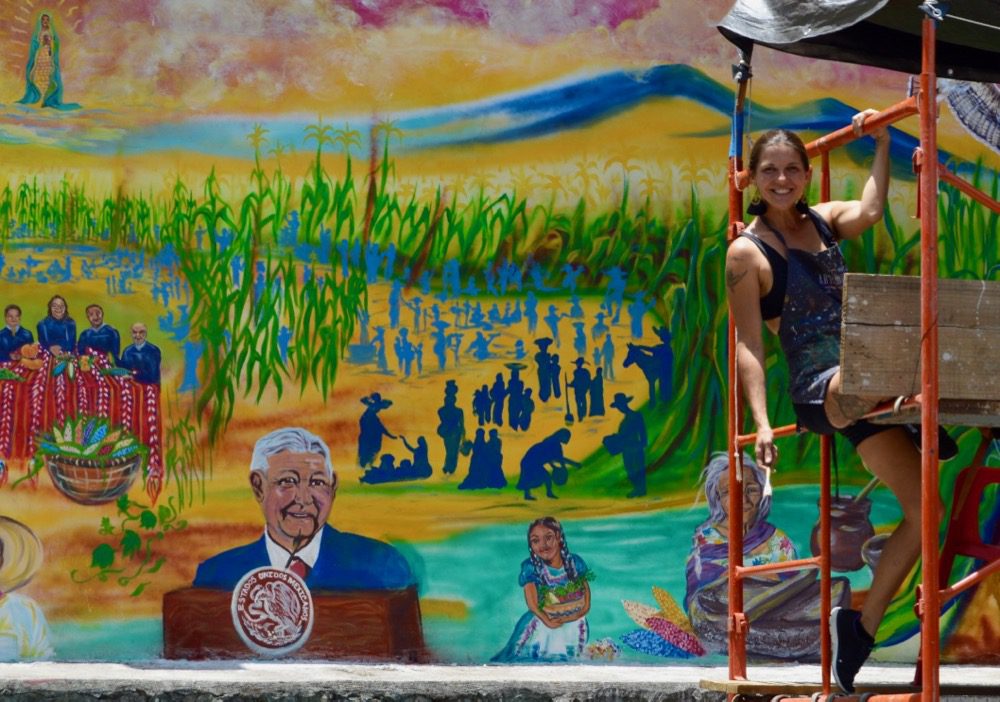
The presidential decree, which was to go into effect in February of this year, was greatly modified under pressure from the US government, which has been arguing that it constitutes a violation of international trade agreements. Lopez Obrador pulled back from the original decree, but has stood strong on a ban on transgenic corn for the staple food for all Mexicans, the tortilla and the masa used to make other traditional foods. Imports of glyphosate (branded in the US as Roundup), the herbicide developed by Monsanto for use with its transgenic “Roundup-Ready” corn varieties, will be phased out by March 31, 2024.
“A transgenic corn plant is a pesticide plant,” said Dr. Ana Ruiz Díaz, a leader in the class-action lawsuit who spoke at the mural inauguration event. “Why? Because it expresses pesticides within itself and because those who eat it transmit these toxins to their descendants. Be it cattle, be it insects, be it human beings.” Ruiz is also the author of the first version of the presidential decree.
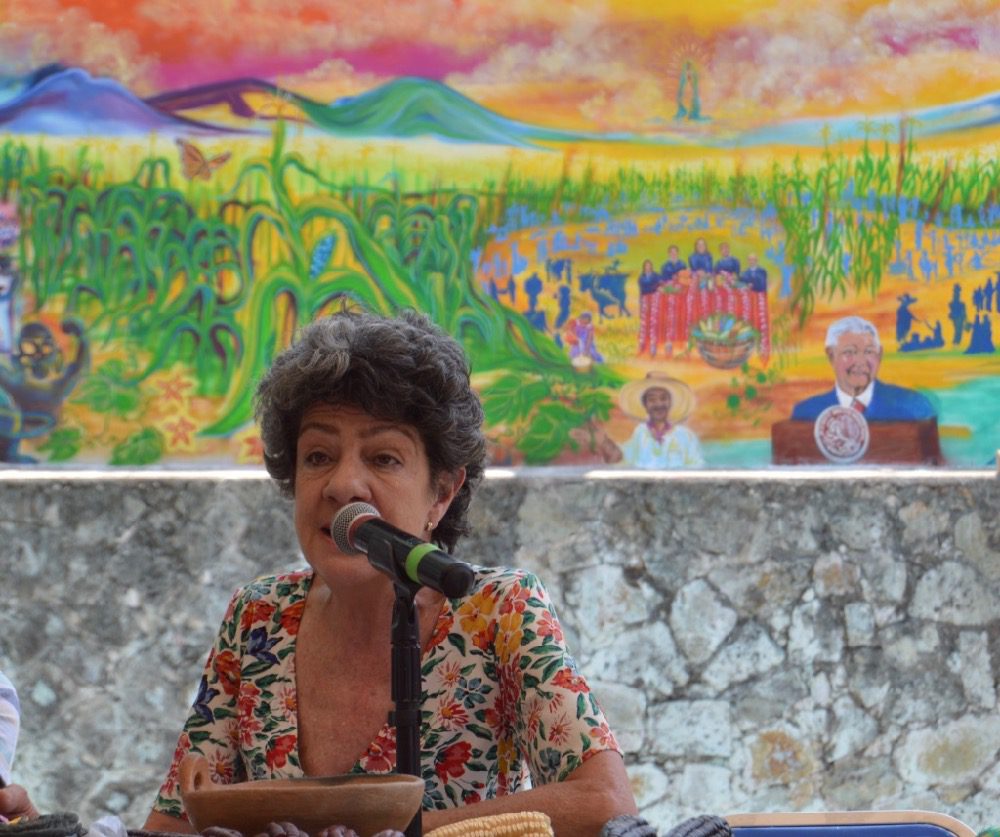
The Demanda Colectiva, as the lawsuit is known here in Mexico, was filed on July 5, 2013, by 53 people including scientists, peasant farmers, beekeepers, human rights and environmental activists against Monsanto and other agroindustrial giants as well as the Mexican Ministries of the Environment and Agriculture. The plaintiffs pointed to the surprise discovery of GMO corn in Oaxaca that had been planted without authorization and had contaminated crops in a nearby farmer’s field. The lawsuit maintained that the cultivation of GMO corn violates the human right to the biological diversity of native corn, and that native corn would be contaminated and its vast biodiversity would be damaged if transgenic corn is released on a large scale.
Just three months later, on Sept. 17 of that same year, a judge representing 10 federal courts granted the collective a precautionary measure, preventing the planting of transgenic corn nationwide as the case worked its way through the courts. That precautionary measure has stood to this day. On Oct. 13, 2021, the Mexican Supreme Court ratified the Precautionary Measure, upholding the ban on granting permits to sow genetically modified corn in Mexico. The high court further affirmed that judges in a class action lawsuit can dictate any precautionary measure necessary to protect the rights of a collective.
Ruiz Díaz of the Demanda Colectiva hailed the mural as a way of keeping the memory alive of these two watershed moments in Mexico’s legal history. “These are two results that we celebrate because the leadership of the Judiciary, that is, the Supreme Court of Justice of the Nation, ruled against the transnationals and against the Federal Executive Branch, that is, against the Secretaries of Environment and Agriculture, and ruled in favor of corn consumers.”
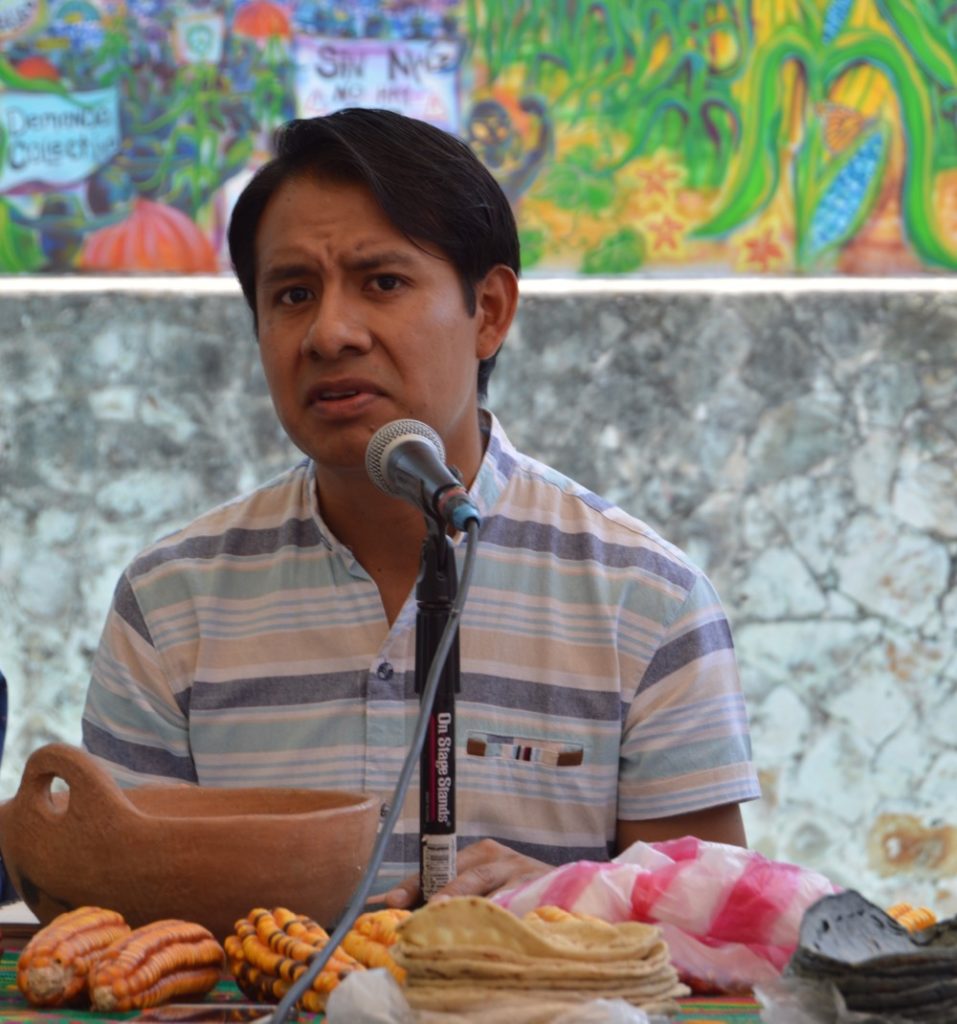
Carlos Morales of the Espacio Estatal del Maíz Nativo de Oaxaca (State Space for the Native Corn of Oaxaca), a collective of civil society and campesino organizations working to defend the diversity of corn, spoke of the importance of traditional and ancestral agricultural techniques.
“In many places in Oaxaca we still have the virtue that there is ancient peasant knowledge that you will not find in biology or science academies, and that, curiously, is what our parents, our grandparents or our great-grandparents, still have. Sometimes it is enough to listen to them.” The transmission of knowledge is fundamental, said Morales.
“Just as we inform them about transgenics, so too can they share information on how the corn is planted in the Sierra Norte, how a ritual is performed in the Isthmus of Tehuantepec, how the seeds are preserved by drying in the sun, or stored with ash, or with dry chili, epazote or hierba santa. All this knowledge must continue to be consolidated.”
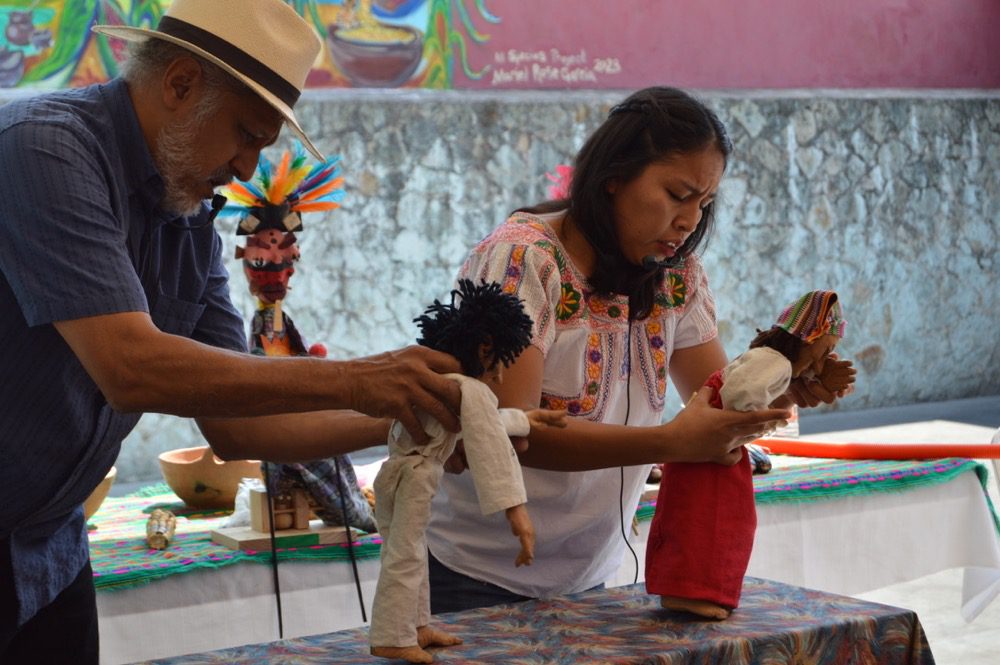
Alejandro Jiménez Molina, a master puppeteer who has been called the Geppetto of Oaxaca, together with partner Soleil Marela, kicked off the inauguration of the mural with an engaging performance peopled with wooden campesinos, Zapotec deities and a fluffy green axolotl. Pitao Cozobi, the plumed and imposing Zapotec god of the corn, had choice words for a pair of campesinos who became ill after switching to a diet of crispy corn chips and soft drinks and no longer had the energy to tend to their milpa.
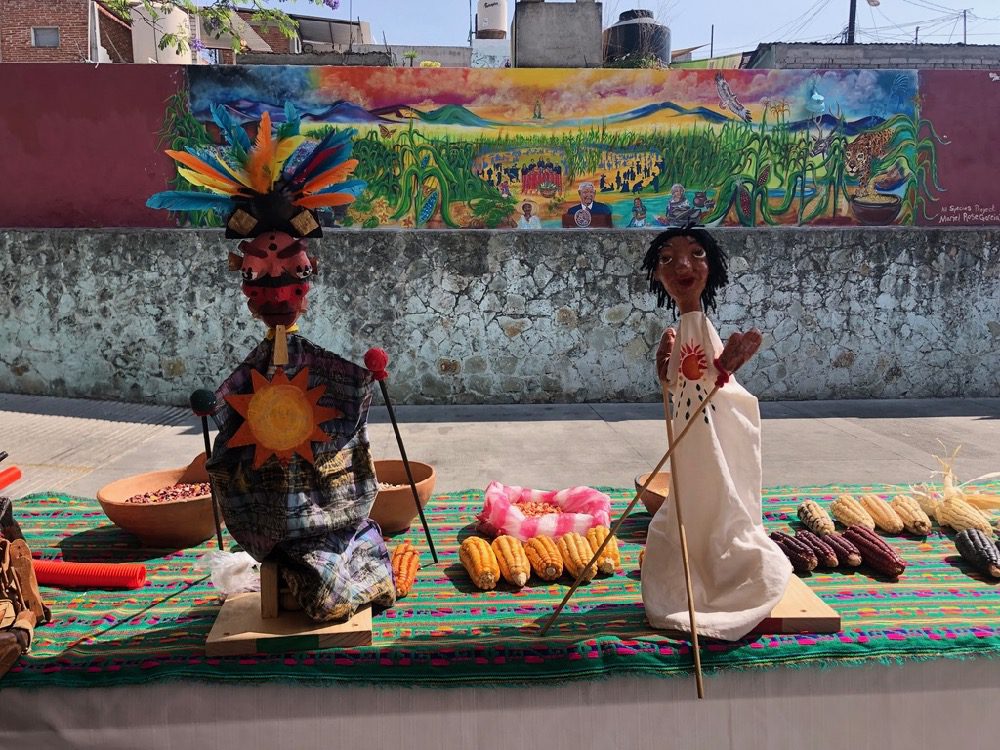
“Corn is our meat, our bones, our being, our life,” intoned Pitao Cozobi through the voice of his puppeteer. “This is a mortal battle between the before and the now, these forces that are trying to change what for more than 10,000 years the peoples of Mesoamerica have achieved: a corn that even today fills the hunger of many peoples. ”
For more information about the Demanda Colectiva Maíz (class action) lawsuit against transgenic corn, see their excellent website: demandacolectivamaiz.mx.
An earlier version of this story appeared in Mexico News Daily.

Demanda Colectiva GMO gylphosate maize Monsanto native corn transgenics
Beautiful article! You all are a great inspiration!
Thank you, Nelson! We know you were there in spirit!!
My spirit is uplifted with your report on the Demanda Collectiva’s success against multi-nationals like Monsanto,who do as they please in the name of profit.
Thank you so much, Rodolfo, for caring about this issue, and for reading and commenting. I will pass your comments along to Ana, Mariel and Chris, who have done so much to make a difference in that fight. I know it will mean a lot to them!